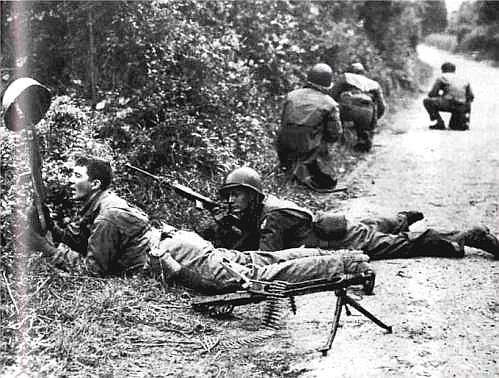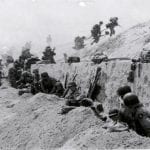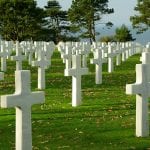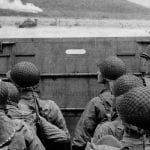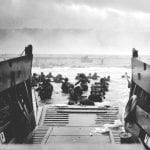This article is a comprehensive list of World War 2 facts, including the primary actors in the war, causes, a comprehensive timeline, and bibliography. Scroll down to learn more.
Click here to see more articles in this category.
“How a WW2 Soldier Persevered Through Concentration Camps, Death Marches, and Starvation”
For the full “History Unplugged” podcast, click here!
World War 2 Timeline
Date |
Summary |
Detailed Information |
| 1938 | German Anschluss with Austria | Hitler went ahead with his plans to unify all German-speaking people. He annexed Austria then demanded the liberation of German people in the Sudetenland region of Czechoslovakia. Neville Chamberlain flew to Germany to attempt a settlement before war broke out. |
| 30 Sept 1938 | Treaty of Munich | Hitler, Chamberlain, Daladier of France and Mussolini of Italy met in Munich and agreed that Hitler should have the Sudetanland of Czechoslovakia. The Czechs were not represented at the meeting and realising that no country would come to their aid were forced to surrender the Sudetenland to Germany. Hitler assured those at the meeting that this was the extent of his ambitions for expansion. Chamberlain returned to England with a piece of paper signed by Hitler, proclaiming ‘peace in our time.’ |
| March 1939 | Hitler invades Czechoslovakia | Despite the assurances given by Hitler in the Treaty of Munich (Sept 1938), he marched into Czechoslovakia and occupied the country. |
| March /April 1939 | Britain rearms and reassures Poland | Britain had begun re-arming and a highly secret radar early warning system was installed along the east coast. Conscription was introduced and assurances were given to Poland, who was being threatened by the Fuhrer. |
| late Aug 1939 | Russia and Germany sign pact | Hitler and Stalin signed a non-aggression pact which included secret clauses for the division of Poland. |
| 1 Sept 1939 | Hitler invades Poland | Adolf Hitler invaded Poland. |
| 3 Sept 1939 | Britain and France declare war on | Britain and France declared war on Germany. Neville Chamberlain broadcast the announcement that the country was at war. |
| Sept 1939-May 1940 | ‘Phoney War’ | The months following Britain’s declaration of war are referred to as the ‘phoney war’ because Britain saw no military action. |
| April/May 1940 | Hitler invades Denmark and Norway | Hitler invaded and occupied Denmark and Norway to safeguard supply routes of Swedish ore and also to establish a Norwegian base from which to break the British naval blockade on Germany. |
| 10 May 1940 | Blitzkrieg | Hitler launched his blitzkrieg (lightning war) against Holland and Belgium. Rotterdam was bombed almost to extinction. Both countries were occupied. |
| 13 May 1940 | Chamberlain resigns | Neville Chamberlain resigned after pressure from Labour members for a more active prosecution of the war and Winston Churchill became the new head of the wartime coalition government. Chamberlain gave Churchill his unreserved support. Ernest Bevin was made minister of labour and recruited workers for the factories and stepped up coal production. Lord Beaverbrook, minister of Aircraft Production increased production of fighter aircraft. |
| 26 May 1940 | Dunkirk (Operation Dynamo) | The British commander-in-chief, General Gort, had been forced to retreat to the coast at Dunkirk. The troops waited, under merciless fire, to be taken off the beaches. A call went out to all owners of sea-worthy vessels to travel to Dunkirk to take the troops off the beaches of Dunkirk. More than 338,000 men were rescued, among them some 140,000 French who would form the nucleus of the Free French army under a little known general, Charles de Gaulle. |
| 11 June 1940 | Italy enter war on side of Axis powers | Italy entered the war on the side of the Axispowers. Italy’s motive for entering the war was the hope of rich pickings from the spoils of war. |
| 22 June 1940 | France signs armistice with Germany | The French, Marshall Petain, signed anarmistice with Germany taking France, which had been devastated, out of the war and into German occupation. |
| 10 July – 31 October 1940 | Battle of Britain | The Battle of Britain comprised four phases: 1. During July Hitler sent his Luftwaffe bombers to attack British ports. His aim was also to assess the speed and quality of response by the RAF. 2. During August the attacks on shipping continued but bombing raids were concentrated on RAF airfields. 3. The Blitz – From September 7th the city of London was heavily bombed. Hitler hoped to destroy the morale of the British people. 4. Night Bombing – With the failure of daylight bombing raids Hitler began a series of nightly bombing raids on London and other important industrial cities. The RAF defended the skies and by October 31 the raids had ceased. |
| 22 Sept 1940 | Tripartite Pact | This pact of mutual alliance was signed by Germany, Italy and Japan. |
| December 1940 | British rout Italians in N. Africa | Italian forces in North Africa were routed by the British led by General Wavell. |
| early 1941 | Italy and Germany attack Yugoslavia | German and Italian troops attacked Yugoslavia, Greece and the island of Crete. German field Marshall Erwin Rommel led the axis powers back to North Africa. |
| 22 June 1941 | Hitler attacks Russia – Operation Barbarossa | Hitler sent 3 million soldiers and 3,500 tanks into Russia. The Russians were taken by surprise as they had signed a treaty with Germany in 1939. Stalin immediately signed a mutual assistance treaty with Britain and launched an Eastern front battle that would claim 20 million casualties. The USA, which had been supplying arms to Britain under a ‘Lend-Lease’ agreement, offered similar aid to USSR. |
| 7 Dec 1941 | Pearl Harbor | The Japanese, who were already waging war against the Chinese, attacked the US pacific fleet at Pearl Harbour, Hawaii, as a preliminary to taking British, French and Dutch colonies in South East Asia. |
| 8 Dec 1941 | Britain and US declare war on Japan | Britain and the United States declared war on Japan. |
| Feb 1942 | Japanese take Singapore | The Japanese captured Singapore from the British, taking some 60,000 prisoners. |
| June 1942 | Battle of Midway | The USA defeated the Japanese navy at the Battle of Midway. Following this victory, the US navy was able to push the Japanese back. |
| Aug 1942 | Allies in N. Africa | General Alexander was given a hand-written directive from Churchill ordering that his main directive was to be the destruction of the German-Italian army commanded by Field-Marshall Rommell together with all its supplies and establishments in Egypt and Libya. As soon as sufficient material had been built up, Alexander handed the campaign over to General Montgomery. |
| 23 Oct 1942 | Battle of El Alamein | Montgomery attacked the German-Italian army in North Africa with a massive bombardment followed by an armoured attack. He then proceeded to chase the routed enemy some 1500 miles across the desert. |
| Nov 1942 | Battle of Stalingrad | The Russians won their first victory against Germany at the Battle of Stalingrad. |
| Nov 1942 | Allies push into N. Africa | British and American forces under the command of General Dwight Eisenhower landed in the NW of Africa and assumed control of French Morocco and Algeria. They gradually closed in on the Germans. |
| May 12 1943 | Axis surrender N Africa | The British and American forces managed to defeat the Axis forces in North Africa |
| July 1943 | Allies invade Sicily | British and US forces invaded Sicily. |
| Aug 1943 | Allies take Sicily | The allied troops had won the island of Sicily. |
| 3 Sept 1943 | Italy surrenders | Mussolini had been thrown out of office and the new government of Italy surrendered to the British and the USA. They then agreed to join the allies. The Germans took control of the Italian army, freed Mussolini from imprisonment and set him up as head of a puppet government in Northern Italy. This blocked any further allied advance through Italy. |
| Nov 1943 | Allies meet at Tehran | Stalin, Roosevelt and Churchill met to co-ordinate plans for a simultaneous squeeze on Germany. They also discussed post war settlements. Churchill mistrusted Stalin; Roosevelt anxious to show that the West would not stand against Russia, went along with Stalin’s wishes for a second front in France and no diversions further east. Churchill was over-ruled and the fate of post-war Eastern Europe was thus decided. |
| Jan 1944 | Leningrad relieved | The siege of Leningrad was lifted by the Soviet army. |
| June 1944 | Rome liberated | Although Italy had surrendered in September, it was only now that the allies were able to liberate Rome from the Germans. |
| 6 June 1944 | D-Day | The allies launched an attack on Germany’s forces in Normandy, Western France. Thousands of transports carried an invasion army under the supreme command of general Eisenhower to the Normandy beaches. The Germans who had been fed false information about a landing near Calais, rushed troops to the area but were unable to prevent the allies from forming a solid bridgehead. For the allies it was essential to first capture a port. |
| July 1944 | Japanese evicted from Burma | British forces under General Slim, with help from guerrilla-fighting Chindits led by Orde Wingate, evicted the Japanese from Burma. |
| 25 Aug 1944 | Paris liberated | The French capital of Paris was liberated from the Germans. |
| 8 Sept 1944 | V2 Flying Bombs | The first V2 flying bombs killed three people in London. |
| Dec 1944 | Battle of the Bulge | Germany launched its final defensive through the Ardennes region of Belgium. However, they were beaten back by the allies. |
| March 1945 | Allies cross the Rhine | The Allies crossed the Rhine while Soviet forces were approaching Berlin from the East. |
| April 1945 | Death of Roosevelt | President Roosevelt died. He was succeeded by President Truman. |
| April 1945 | Russians reach Berlin | The Russians reached Berlin shortly before the US forces. |
| 28 April 1945 | Mussolini captured and executed | Italian partisans captured Mussolini and executed him. |
| 30 April 1945 | Hitler commits suicide | The German leader, Adolf Hitler committed suicide in his bombproof shelter together with his mistress, Eva Braun, who he had, at the last minute, made his wife. |
| 2 May 1945 | German forces surrender | German forces in Italy surrendered to the Allies. |
| 4 May 1945 | German forces surrender | German forces in north west Germany, Holland and Denmark surrendered to Montgomery on Luneburg Heath. Admiral Donitz, whom Hitler had nominated as his successor, tried to reach agreement to surrender to the Western allies but to continue to fight the Russians. His request was refused. |
| 7 May 1945 | Donitz offers unconditional surrender | Hitler’s successor, Admiral Donitz, offerred an unconditional surrender to the allies. |
| 8 May 1945 | V.E. day | Victory in Europe was celebrated. |
| 5 July 1945 | Churchill loses election | Winston Churchill lost the election to Clement Atlee’s Labour Party. The Labour party promised sweeping social reforms including nationalisation of the coal and railway industries and the creation of a welfare state. The Labour party gained 393 seats to the Conservatives 213. It was generally accepted that the landslide victory for Labour was due to the men and women of the armed services who did not want to resume civilian life under the conditions that they had before they entered service. |
| 6 Aug 1945 | Atomic bomb dropped on Hiroshima | The Japanese generals refused to surrender. The US dropped an atomic bomb on the Japanese city of Hiroshima. |
| 8 Aug 1945 | Russia declares war on Japan | Russia declared war on Japan and invaded Japanese-ruled Manchuria. |
| 9 Aug 1945 | Atomic bomb dropped on Nagasaki | The US dropped an atomic bomb on the port of Nagasaki as the Japanese had not surrendered following Hiroshima. |
| 14 Aug 1945 | Japanese surrender | The Japanese unconditionally surrendered to the allies ending the second world war. |
| 2 Sept 1945 | MacArthur accepts Japan’s surrender | US General, Douglas MacArthur, accepted Japan’s surrender thus formally ending the second world war. |
World War 2 Facts—Statistics and Data
Axis |
Allies |
Occupied |
Neutral |
|---|---|---|---|
| Bulgaria Finland Germany Hungary Italy Japan Romania |
Argentina Australia Bolivia Brazil Canada China Chile Columbia Costa Rica Cuba France India Iraq Lebanon Mexico New Zealand Paraguay South Africa Soviet Union United Kingdom United States |
Albania Belgium Czechoslovakia Denmark Estonia Ethiopia France Greece Luxemburg Netherlands Norway Philippines Poland Yugoslavia |
Andorra Ireland Liechtenstein Portugal Spain Sweden Switzerland Turkey (until Feb 1945) Uruguay Vatican City |
Main Leaders
Country |
Leader |
| France | Charles de Gaulle (Free French forces) Henri-Phillipe Petain – Vichy France |
| Germany | Adolf Hitler |
| Italy | Benito Mussolini |
| Japan | Emperor Hirohito |
| Russia | Josef Stalin |
| United Kingdom | Neville Chamberlain to 1940 Winston Churchill from 1940 |
| United States | Franklin Roosevelt died 1945 Harry Truman 1945 |
Numbers of Deaths
Death figures for World War Two vary from source to source. The figures below are believed to be reasonably accurate
Country |
Military |
Civilian |
Total |
| USSR | 12 million | 15 million | 27 million |
| China | 1.8 million | 7.5 million | 9.3 million |
| Poland | 400,000 | 5.86 million | 6.26 million |
| Germany | 3.25 million | 2.44 million | 5.69 million |
| Japan | 1.5 million | 500,000 | 2 million |
| Yugoslavia | 305,000 | 1.35 million | 1.66 million |
| Romania | 450,000 | 465,000 | 915,000 |
| Hungary | 200,000 | 600,000 | 800,000 |
| France | 245,000 | 350,000 | 595,000 |
| Great Britain | 403,000 | 92,700 | 495,000 |
| Italy | 330,000 | 100,000 | 430,000 |
| Austria | 280,000 | 125,000 | 405,000 |
| United States | 407,000 | 6,000 | 413,000 |
| Greece | 60,000 | 350,000 | 410,000 |
| Czechoslovakia | 7,000 | 315,000 | 322,000 |
| Netherlands | 13,700 | 236,000 | 249,000 |
| Philippines | 27,000 | 91,000 | 118,000 |
| Belgium | 23,000 | 76,000 | 99,000 |
| Finland | 80,000 | 10,000 | 90,000 |
| Bulgaria | 10,000 | 51,000 | 61,000 |
| Canada | 39,000 | 39,000 | |
| Australia | 35,000 | 35,000 | |
| Albania | 20,000 | 10,000 | 30,000 |
| India | 25,000 | 25,000 | |
| New Zealand | 17,000 | 17,000 | |
| *Civilian numbers include those killed as a result of the Holocaust* | |||
Victims of the Holocaust
Country |
Number Of Deaths |
| Poland | 3 million |
| USSR | 1 million |
| Romania | 350,000 |
| Hungary | 250,000 |
| Czechoslovakia | 250,000 |
| Germany | 165,000 |
| Lithuania | 130,000 |
| Netherlands | 105,000 |
| Lathvia | 70,000 |
| France | 65,000 |
| Austria | 65,000 |
| Greece | 65,000 |
| Yugoslavia | 60,000 |
| Bulgaria | 48,000 |
The Rape of Nanking
The Rape of Nanking, also known as the Nanking Massacre happened during the Sino-Japanese war and is said to have been a brutal murder of between 40,000 and 300,000 civilians in China’s capital city. The massacre happened over six weeks in December of 1937 and is considered the worst atrocity committed during the World War II era.
Preceding Events
Before Nanking was invaded by the Japanese military, a tough battle took place at Shanghai. The Japanese Army was met with stiff resistance from the Chinese, something they had not expected and which infuriated the Japanese to such an extent that it gave them an appetite for revenge. When the Japanese finally reached and conquered Nanking, they invaded the city with orders to kill all of the captives.
Massacre
The Japanese saw surrender as an atrocity and had little respect for the 90,000 Chinese soldiers who surrendered. They killed them all, some in horrendous ways. After slaying the men, the Japanese allegedly went on and gang-raped over 20,000 women before killing them too. For six weeks there were citywide stabbings, burnings, strangulations, rapes, drownings, thefts and massive destruction of property. It is said that the streets of Nanking literally ran red from all the blood.
Controversy
Key perpetuators of the Nanking Massacre were tried in front of the International Military Tribunal of the Far East, as well as the Nanjing War Crimes Tribunal, found guilty and executed. The event however is still highly debated politically. Several historians and Japanese nationalists have claimed that it has either been fabricated or highly exaggerated for war propaganda. The issue is still a stumbling block in Japanese relations with China and other Asian nations.
World War 2 Facts — What Started WW2?
Although a variety of different factors caused World War Two, the main event and the trigged for what started WW2 was Germany’s invasion of Poland in September 1939.
Of course the invasion was preceded by decades of political conflict. The Treaty of Versailles, signed at the end of WW1, placed some very harsh restrictions on Germany, which created a feeling of resentment among the Germans. Due to the financial depression of the 1920’s, Germany simply did not have the funds to pay the reparation fees demanded by the treaty.
Other countries were sympathetic and acted very lenient towards Germany, overlooking other clear violations of the Treaty, such as a union with Austria. They also decided not to interfere when Hitler began to expand his army and, afraid of starting another war, did nothing when he claimed back former German land from Czechoslovakia. When they however realized that Hitler was setting his sights on Poland in his plight to expand his empire, this was the last straw. As soon as Hitler attacked Poland, Britain and France declared war against Germany.
Explanations from Propaganda
For those wondering how Hitler managed to get the German nation to support the invasion of Poland; Hitler did some very clever marketing in the form of propaganda. While the practice of manipulating public opinion is a mainstay of any political party today, it was an innovative practice in the early Twentieth Century. Nobody perfected this practice better than the Nazis, who devoted entire offices to propaganda and treated it with the same scientific thoroughness as weapons research.
Months before the 1939 invasion of Poland, Hitler and the German press accused the Polish of performing violent “ethnic cleansing” of Germans that were living in Poland. Adolf Hitler also ran several false flag operations such as the Gleiwitz incident, where he dressed his own men in Polish uniforms and ordered them to attack German stations. Needless to say, the Germans believed that Germany had to retaliate and that war with Poland was justified.
Conscription Definition
Conscription literally means compulsory military service.
Unlike other European countries, Britain had always relied on volunteers to fight in times of war. Conscription had been introduced in 1916 when more men were needed to fight in the trenches, but it was abandoned when the war ended.
During the 1930s some men still chose to enter the armed forces after leaving school and in 1937 there were 200,000 soldiers in the British army. The government knew that this was not enough to fight a war with Germany and in April 1939 introduced the Military Training Act. The terms of the act meant that all men between the ages of 20 and 21 had to register for six months’ military training. At the same time a list of ‘reserved occupations’ was published. This listed occupations that were essential to the war effort and stated that those employed in those jobs were exempt from conscription.
Reserved Occupations
- Dock Workers
- Miners
- Farmers
- Scientists
- Merchant Seamen
- Railway Workers
- Utility Workers – Water, Gas, Electricity
When war broke out in September 1939, some men volunteered to join the armed services, but Britain could still only raise 875,000 men. Other European countries had kept conscription between the wars and were able to raise much larger armies than Britain. In October 1939 the British government announced that all men aged between 18 and 41 who were not working in ‘reserved occupations’ could be called to join the armed services if required. Conscription was by age and in October 1939 men aged between 20 and 23 were required to register to serve in one of the armed forces. They were allowed to choose between the army, the navy and the airforce
As the war continued men from the other registered age groups received their ‘call-up’ papers requiring them to serve in the armed forces. In 1941 single women aged between 20 and 30 were also conscripted. Women did not take part in the fighting but were required to take up work in reserved occupations – especially factories and farming – to enable men to be drafted into the services.
Men who were too old, young or not completely fit joined the Home Guard, known as Dad’s Army
Conscientious Objectors
Conscientious objectors were men who, for moral or religious reasons felt unable to take part in the war. The government set up tribunals and those who objected to taking part in the war had to apply for Conscientious Objector status and give their reasons before a panel of officials. The panel had the authority to grant full exemption from any kind of war work, to grant exemption from military service only or to dismiss the application. Approximately 60,000 men applied for Conscientious Objector status. Of those around 18,000 were dismissed.
World War 2 Facts — Fascism
The label “Fascism” is used to describe any movement or political ideology inspired by Benito Mussolini’s Italian Fascism. As a rule, Fascism is associated with dictatorship or a strict hierarchical, authoritarian structure where the state gets total control. Adolf Hitler and Benito Mussolini’s beliefs are two prime examples of what people today consider to be fascist.
An Anti-Movement
Fascism developed in Europe, especially Italy, in the early 20th century and is said to be inspired by national syndicalism. The ideology is opposed to Marxism, liberalism and traditional conservatism, but it also borrows practises and concepts of all of these ideologies. Instead of focusing on class conflict, like the socialists, fascists focus more on races and nations. Fascism rejects the liberal thinking of a representative government and individual rights, while at the same time advocating for public participation in politics and making use of parliamentary channels. It rejects conservative views, yet often paints the past in a romantic light to inspire “national rebirth.” Fascists believe in having a mixed economy, with the goal of achieving national independence and self-sufficiency. Imperialism, political violence and war are all seen as a way to achieve national rebirth and many fascists claim that there is nothing wrong with displacing other, weaker nations by expanding your territory.
Left or Right?
Most people place fascism on the far-right spectrum, because of fascist leaders such as Hitler that advocated racial superiority. There are however scholars who say that this description is not accurate as fascism also incorporates certain leftist beliefs. In 1919, Mussolini described fascism as a movement that is against the “backwardness of the right and the destructiveness of the left.”
Use of the Word
Instead of being used as an accurate categorization of an ideology, today, the word “fascist” is most often used as an insult to describe a person that has viewpoints perceived as intolerant, authoritarian or far-right.
When Did America Enter WW2?
America officially only enter World War 2 two years into the war on December 8, 1941, when all but one member of Congress passed the motion one day after the attack on Pearl Harbor in Hawaii. Although America formally maintained neutrality up until that moment, the U.S. has long been involved in the war, providing support to the Allies.
Not That Neutral
In the first two years of the war, America remained politically neutral, but president Franklin was working hard to prepare the Americans for what he regarded to be an inevitable conflict. He felt that the war was threatening U.S. security and tried to find ways to help the European Allies without being formally involved in the war. He persuaded Congress in November 1939 to repeal the arms embargos that were part of the neutrality law and pass the Fourth Neutrality Act, which allowed him to trade arms with countries whose defence he would seem to be vital to the security of the United States. The U.S. would also provide its air force and navy to “escort” British convoys that transported supplies “leased” from America to protect them from enemy submarines. The U.S. military was also deployed to replace British forces in Iceland after the British invasion there.
Why Japan Attacked
In coordination with the Dutch and the British, the U.S. was running a very successful oil embargo against Japan. At that time the Japanese were advancing on China and French Indochina and, because they imported 90% of their oil, they became desperate. A lack of oil threatened to end all of their war efforts and as they were refusing America’s demands to stop fighting China, the Japanese decided that war with America was inevitable, their only hope was to attack first.
So when did America enter WW2? Officially after the bombing of Pearl Harbor, but the United States had been moving toward allianceship with Allied Powers for years.
The Home Front: WW2
Although it was the men who went off to fight the war, the people left behind at home also had a part to play in the war. The Home Front is the name given to the effect of the war on people’s everyday lives.
Evacuation
When the war began in September 1939 the government knew that large cities would be the target for German bombs and that casualties would be high. Evacuation was introduced to move school children, teachers, mothers with children under the age of five and disabled people out of the cities to the countryside where there was little risk of bombing raids.
Evacuation was voluntary and the government expected more than 3 million people to take advantage of the scheme. However, by the end of September 1939 only 1.5 million people had been evacuated and most of those returned to their homes when there were no bombing raids. When the Battle of Britain and the Blitz began in 1940, evacuation was re-introduced.
The children to be evacuated assembled in the school playground. They all wore name tags and had to carry their gas mask as well as their belongings. After saying goodbye to their parents they travelled by train or by coach to their destination where they met the people who were to house them. Most of those evacuated had no idea what their life as an evacuee would be like nor when they would see their parents again.
Rationing
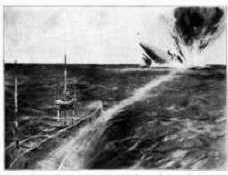
Britain has always imported food and other goods from overseas. Being an island this means that goods come into the country by ship or air. In 1939 most goods were transported to Britain by ship.
From the beginning of the war, one of Hitler’s tactics against Britain was to use submarines to torpedo ships bringing supplies to Britain. This meant that imported goods were in short supply.
The government introduced rationing to make sure that everyone had a fair share of what was available.
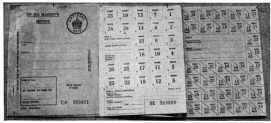
Every man, woman and child was given a ration book for food and had to register with a grocery store. The grocery store was only given enough food for the people on their list. When someone bought rationed food, the grocer stuck a sticker in his or her ration book to show that that week’s ration had been purchased.
At first only butter, sugar and bacon was rationed. By the middle of 1940 all meat, eggs, cheese, jam, tea and milk was also rationed. Clothes were rationed from June 1941 due to a shortage of raw materials and also to allow the factories and workers to concentrate on producing weapons, aircraft and ammunition for the war.
One Person’s Weekly Food Allowance
| 4oz (113g) | lard or butter |
| 12oz (340g) | sugar |
| 4oz (113g) | bacon |
| 2 | eggs |
| 6oz (170g) | meat |
| 7oz (57g) | tea |
Vegetables were not rationed but were often in short supply. People who had gardens were encouraged to plant vegetables instead of flowers. The government called this ‘Digging for Victory’ and produced posters to persuade people that they were helping to win the war by planting vegetables.
The only fruit that was available was that grown in Britain e.g. apples, pears, and strawberries. Bananas, oranges, peaches and other imported fruit were not available at all.
Dried egg powder was available and was used to make scrambled eggs.
Clothes Rationing
Everyone was given a book of 66 coupons to use to buy new clothes for one year.
This was cut to 48 in 1942 and 36 in 1943. Each item of clothing cost a certain number of coupons.
Item |
Men |
Women |
Children |
|---|---|---|---|
| Raincoat | 16 | 15 | 11 |
| Overcoat | 7 | 7 | 4 |
| Jacket | 13 | 12 | 8 |
| Shirt/Blouse | 5 | 4 | 3 |
| Jumper/Cardigan | 5 | 5 | 3 |
| Trousers | 8 | 8 | 6 |
| Shorts | 3 | 3 | 2 |
| Skirts | 8 | 6 | |
| Boot/Shoes | 7 | 5 | 3 |
| Nightdress/Pyjamas | 8 | 6 | 6 |
| Underpants/Knickers/Vest | 3 | 3 | 2 |
| Socks/Stockings | 2 | 2 | 1 |
Second hand clothes were not rationed and children’s clothes were handed down from one child to the next or sold on to other families. The government used the slogan ‘Mend and Make Do’ to encourage people to repair or patch torn or worn clothes.
Women
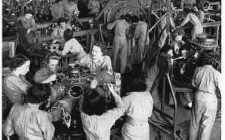
As more and more men were ‘called up’ to serve in the forces, women were called upon to take over the jobs traditionally done by men.
Women worked in the factories producing aircraft, ammunition, weapons and other goods needed for the war effort. They worked long hours and could earn as much as 40 shillings (£2.00) a week. This was quite a good wage in the 1940s but was less than the men had been paid for doing the same job.

The women who worked in the fields and on farms were known as Land Girls. They were given a uniform and had to live on the farms where they were sent to work. They worked long hours and the work was hard. Land Girls were paid 32 shillings (£1.60) per week.
Other jobs done by women included:
Women’s Voluntary Service (WVS), Air Raid Wardens, Auxillary Territorial Service (ATS), Women’s Auxillary Air Force (WAAF), Women’s Royal Naval Service (WRNS), Special Operations Executive (SOE) [known as Secret Agents or Spies], Entertainers
Home Guard

The Home Guard or Local Defence Volunteers (LDV) was formed in 1940 when there was a real risk that Hitler might invade Britain. The men that served in the Home Guard were all volunteers and were mostly those that were too old (over the age of 40) or too young (under the age of 18) to serve in the forces. They became known as ‘Dad’s Army’.
The men were issued with a uniform and an armband with the letters LDV to show that they were members of the Home Guard. Members of the public were asked to donate any rifles, pistols or shotguns that they might have to provide the Home Guard with weapons. Those that were not provided with weapons made makeshift weapons from pieces of pipe or knives.
Most of the men had full time jobs and trained in the evenings. As well as preparing themselves to be ready to fight off a German invasion, the Home Guard also guarded buildings that had been bombed to prevent looting, helped to clear bomb damage, helped to rescue those trapped after an air raid, guarded factories and airfields, captured German airmen that had been shot down and set up roadblocks to check people’s identity cards.
World War Two Facts — The Blitz
In the summer of 1940, Hitler decided to invade Britain. His plan was to take control of the English Channel by destroying the Royal Airforce and then to send German troops into Britain to take control.
In July 1940, Hitler put his plan into operation. The German airforce (Luftwaffe) began making daily bombing raids on British ships, ports, radar stations, airfields and aircraft factories. This became known as the Battle of Britain.
The Royal Airforce took to the skies and there were many battles between British and German planes over the Channel and South Coast. Although British losses were high, German losses were higher and at the beginning of September Hitler decided to try a new tactic to conquer Britain.
Bombing Raids
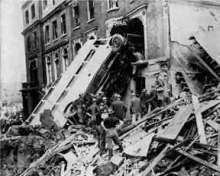
Hitler believed that by targeting civilians he could force the British to surrender and on 7th September 1940 began his daily bombing campaign. London was the main target but other major cities were also bombed. Casualties were high. On the first day of bombing 430 people were killed and 1,600 badly injured.
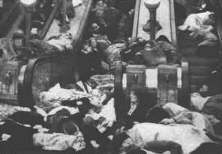
Within a few weeks the daily bombing raids had become nightly raids. Hitler decided to make the bombing raids at night to increase the ‘fear factor’ and also to make people weaker by not allowing them to sleep properly. People in London slept in underground stations for protection.
Shelters
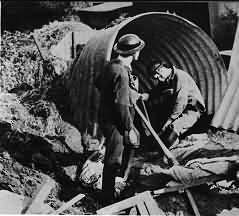
There were public shelters in most towns, but many people built Anderson shelters in their gardens so that they had protection if they were unable to get to the public shelter. Anderson shelters were made out of corrugated iron and were very strong. A hole was dug in the garden, then the shelter was placed in the hole and it was covered with earth. An air-raid siren warned people when a raid was about to begin.
The government tried to confuse the German bombers by enforcing a ‘blackout’. Street lamps were switched off, car headlights had to be covered and people had to hang black material in their windows at night so that house lights could not be seen. Going out at night could be dangerous during the blackout; cars crashed into each other and pedestrians, people walked into each other, fell off bridges or fell into ponds.
After May 1941, the bombing raids became less frequent as Hitler turned his attention to Russia. Nevertheless, the effects of the Blitz were devastating. 60,000 people lost their lives, 87,000 were seriously injured and 2 million homes were destroyed.
What was Operation Overlord?
Operation Overlord was the code name of what is known today as D-Day, the invasion of Europe via Normandy in June 1944, which ended up a great success. By 1944 Nazi Germany was controlling France and most of Western Europe, making it very hard for the Allies to launch attacks. To get a foothold in Europe, they needed to find a way to get a large amount of men to the other side of the English Channel. Moving around 160,000 troops was quite a feat and required a lot of planning and preparation. The invasion started with air support, of 1,200 planes, followed by an amphibious assault of close to 6,000 vessels.
Why Normandy?
Pays de Calais, which is where France and Britain are closest to one another, was the most obvious choice for an invasion, but the Allies under command of General Dwight Eisenhower decided on Normandy instead. Because the Germans were expecting an attack at Pays de Calais, that area was very well defended and the Nazis concentrated their forces there. The trick was to keep reinforcing that belief to keep them focussing on Pays de Calais and to carry out such a large-scale operation without the Germans getting word of it via spies or interception. Normandy did have large enough beaches to receive a mass landing of soldiers and equipment, but the building of artificial harbors would be required.
Challenges
Eisenhower faced many challenges when planning this invasion. Equipment and aeroplanes were a large headache, as such a large scale operation they needed enough air support and most aeroplanes were already in use in other WW2 conflicts. There were also not enough ships in England to carry all the men, which meant they had to be built, along with the artificial harbors and amphibious tanks used to make the landing.
Result
Although the Allies didn’t exactly reach their goals on the first day, Operation Overlord was a great success. By the end of August, over three million allied troops were stationed in France. The Germans made a counterattack on 8 August, which failed miserably and left 50,000 Nazi soldiers trapped in the Falaise pocket. On 15 August, South France was invaded during Operation Dragoon and France was liberated by 25 August.
The Yalta Conference
As World War II was heading to its end, the Allied leaders, Stalin, Roosevelt and Churchill met at Yalta in the second of three meetings of the so-called “Big Three”. This conference had the code name, the Argonaut Conference, and is also sometimes called the Crimea Conference, because it was held at a crimean port on the Black Sea. During this conference, the leaders discussed what was to happen during the final stages of WW2 and how to regulate a post-war Europe. The agreements made during the conference were kept secret initially, but became quite controversial later, especially during the Cold War.
Some Key Agreements:
- The three leaders agreed that Germany was to surrender unconditionally
- Germany and Berlin were to be split up in four occupational zones
- Division of other territories were discussed and agreed upon
- Stalin agreed to allow free elections in Eastern Europe
- Stalin also promised to get involved in the war against Japan, on the condition that he gets the lands back that were conquered by Japan during the 1904-05 Russo-Japanese War.
- Stalin wanted 16 Soviet Socialist Republics to be allowed to join the United Nations, but 14 of them were denied.
- The leaders agreed that a “Committee on Dismemberment of Germany” had to be established.
World War 2 Facts – WW2 Operations: D-Day and Beyond
World War 2 Facts: The overall strategy that led to D-Day and other WW2 operations was part and parcel of multiple strategies of World War Two. Some were never executed, as realities on the ground made their implementation impossible. Here are significant operations of note:
World War 2 Facts: OPERATION ANVIL-DRAGOON
The Anglo-American invasion of southern France in August 1944.
Original plans postulated simultaneous landings in Normandy and the Riviera, but the Allies lacked adequate shipping. Consequently, AnvilDragoon occurred nine weeks after Neptune-Overlord and involved many of the naval forces present off Normandy. Though Winston Churchill largely opposed the operation, the Mediterranean beaches later contributed nearly 40 percent of the logistics to the Anglo-American drive into Germany.
World War 2 Facts: OPERATION BODYGUARD
The combination of Allied deception plans for D-Day.
World War 2 Facts: OPERATION BOLERO
The buildup of Allied forces in Britain prior to Overlord.
OPERATION COBRA
The breakout from the Normandy beachhead, planned by Lt. Gen. Omar Bradley and his First Army staff. Following several delays, Cobra was launched on 25 July beneath a crushing carpet of bombs. The resulting moonscape from hundreds of Allied bombers either destroyed or trapped German forces in the area, but poor coordination between U.S. air and ground commanders resulted in hundreds of American casualties as well.
OPERATION COCKADE
Part of a multifaceted global scheme to deceive the Axis as to Allied intentions. Cockade postulated an invasion of Occupied Europe in 1943.
OPERATION FORTITUDE
Contingency plans for the Allied invasion of Europe. Fortitude North postulated Norway; Fortitude South focused on the Pas de Calais.
OPERATION NEPTUNE
The naval phase of the Normandy invasion. Briefly stated, its goal was to deliver Allied armies to the D-Day beaches, where the ground phase— Operation Overlord—would begin at the water’s edge.
Overall command of Neptune was the responsibility of Adm. Sir Bertram Ramsay, an extremely capable and highly experienced Royal Navy officer. He had worked closely with Gen. Dwight Eisenhower in the Mediterranean theater and had the supreme commander’s confidence.
OPERATION OVERLORD
The Allied campaign to enter the European continent. The naval phase—the movement of troops and equipment from Great Britain to northern France—was Operation Neptune. General Eisenhower’s ground commander was Gen. Bernard Montgomery, leading the Twenty-first Army Group, composed of British and Canadian forces.
OPERATION SLEDGEHAMMER
A proposed plan for British and American landings in France during the latter part of 1942. Never seriously contemplated, Sledgehammer was a contingency measure in the event of impending defeat of the Soviet Union. The operation was largely of American origin and would have had the effect of mollifying Soviet premier Joseph Stalin’s demand for a second front, but it almost certainly would have failed.
OPERATION TIGER
An amphibious exercise conducted on the Devonshire coast from 22 to 30 April 1944, Tiger became the worst American training disaster of the Second World War. A stretch of beach called Slapton Sands in Start Bay was selected for Tiger because it resembled part of the Normandy coast. In the early morning of the 28th, five LSTs from Plymouth and three from Brixton embarked some four thousand troops, many attached to the Fourth Infantry Division. Despite Royal Navy patrols in the English Channel, nine E-boats from Cherbourg penetrated the exercise area and launched a brief, devastating torpedo attack. Two LSTs were quickly sunk, and a third was damaged. The German raiders escaped.
Initial American losses were listed as 198 navy and 441 army personnel, but subsequently another 110 army men were determined killed or missing. The total of 749 dead was a toll unequaled in the U.S. military for any wartime training loss. The heaviest casualties occurred among quartermaster and engineer companies. The losses were largely replaced in the next five to six weeks.
In the 1980s and ’90s British and American reporters ‘‘discovered’’ Tiger and produced an ‘‘exposé’’ of the disaster. However, the U.S. Army had announced the event in August 1944, four months after it occurred and just two months after Overlord. The story of Slapton Sands was largely lost in the excitement surrounding the Normandy landings and Allied breakout from the coast, while Tiger’s losses were absorbed in the larger toll in France.
WW2 Medals: American, British, and German
World War 2 Facts – American
Medal of Honor
The highest military decoration in the U.S. armed forces, and among the most famous of WW2 medals, is the Medal of Honor, sometimes called the Congressional Medal of Honor, because it is presented in the name of Congress. Established during the Civil War, it has been awarded more than three thousand times, including some 450 for World War II actions. The number of retroactive awards frequently changes, as regulations regarding the statute of limitations are being waived with increasing frequency. Based on the total 16,112,000 Americans under arms in World War II, one Medal of Honor was presented for every thirty-five thousand personnel. That figure is 65 percent higher than the British Empire ratio for Victoria Crosses.
Four Medals of Honor were awarded for D-Day actions. The most senior recipient was Brig. Gen. Theodore Roosevelt, Jr., assistant commander of the Fourth Infantry Division and son of the late president, who himself had been nominated for leading the First Volunteer Cavalry in Cuba in 1898. The younger Roosevelt’s leadership under fire on Utah Beach was judged beyond that normally expected of a general officer. His father received the medal a century after the Spanish-American War.
Three Medals of Honor went to men of the First Division. First Lt. Jimmie W. Montieth and Tech. 5 John J. Pinder, Jr., both of the Sixteenth Infantry, received posthumous awards for combat around Colleville-surMer on 6 June. Another Big Red One soldier, Pvt. Carlton W. Barrett of the Eighteenth Regiment, repeatedly braved enemy fire to rescue wounded comrades at St. Laurent-sur-Mer.
Six other soldiers received the Medal of Honor in the twelve days following D-Day; eight of the ten total awards were posthumous.
Distinguished Service Cross
In the U.S. Army the Distinguished Service Cross ranks second only to the Medal of Honor in prestige. It was authorized in July 1918, during the First World War, because prior to that time the Medal of Honor had been the only American decoration for military heroism. The criteria established by President Woodrow Wilson and Congress held that the DSC could be presented to army officers and enlisted men for actions that did not merit the Medal of Honor but reflected extraordinary heroism in military operations against an armed enemy of the United States. During the Great War, 6,068 DSCs were awarded, as well as 111 Oak Leaf Clusters for subsequent acts by initial recipients.
Approximately 280 men won DSCs for D-Day actions, including noncommissioned officers and enlisted men. The distinction between Medal of Honor and DSC awards is often difficult to discern, as some DSC recipients probably deserved the greater honor. Among many examples was Brig. Gen. Norman D. Cota of the Twenty-ninth Infantry Division, who directly supervised automatic weapons and placement of explosive charges and otherwise exercised a type of combat leadership seldom expected of a general officer.
Navy Cross
The naval equivalent of the DSC was the Navy Cross, awarded to members of the U.S. Navy, Marine Corps, and Coast Guard, and occasionally to Army personnel for operations under naval control. It was established in February 1919 and remained third highest of the navy decorations until August 1942, when it was elevated beyond the Distinguished Service Medal.
The number of D-Day Navy Crosses is unknown, but apparently most recipients were beachmasters and combat engineers. Naval demolition units at Omaha Beach received seven Navy Crosses. More than 3,600 were presented in World War II, including 2,661 to navy personnel, 946 to marines, and six to Coast Guardsmen, with the balance to individuals of the U.S. Army and the Allies.
Silver Star
The third-ranking combat decoration was established in 1932 to replace the Citation Star, which often went to Distinguished Service Cross nominees who did not receive the DSC. Approximately eighty thousand Silver Stars were awarded during World War II. A lesser decoration was the Bronze Star, a ground combat or support award roughly equivalent to the Air Medal.
World War 2 Facts – WW2 Medals: British
Victoria Cross
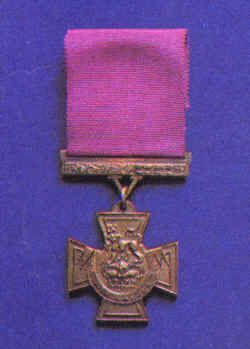
The highest military decoration of the British Empire and best known of its WW2 medals is the Victoria Cross; the first, presented by Queen Victoria in 1856, were cast from Russian cannon captured in the Crimean War. At of the end of the twentieth century, only 1,354 VCs had been awarded in the previous 144 years. Almost half had been presented for actions in the First World War.
Of the 182 VCs awarded during World War II, just one was earned on D-Day. Company Sgt. Maj. Stanley Elton Hollis belonged to the Sixth Battalion of the Green Howards, which landed with the Fiftieth Division on Gold Beach. During the day Hollis cleared two German bunkers largely singlehanded, using automatic weapons. He was seriously wounded in September but remained in the territorial (regional) army until 1949. Hollis died in 1972.
The Commonwealth total included twenty-seven VC recipients from India (eight Ghurkas), twenty Australians, sixteen Canadians, eight New Zealanders, three South Africans, a Rhodesian, and a Fijian. During World War II the British Commonwealth had some 10,570,000 personnel on active duty; the 182 VCs represented one in fifty-eight thousand individuals, compared to one in about thirty-five thousand Americans awarded the Medal of Honor. Proportionately the highest ratio of VCs in World War II went to New Zealanders (one in twenty-four thousand troops) and Australians (one in fifty thousand).
Distinguished Service Order
The Distinguished Service Order was established in 1886 and became the British Empire’s second-ranking military decoration, after the Victoria Cross. Awarded to officers, the DSO is an extraordinarily attractive medal— a white cross with gold crown and green laurel wreath in the center, suspended from a red ribbon with blue borders. It was chartered for officers mentioned in dispatches for actions ‘‘in the face of the enemy.’’ The DSO was first awarded in significant numbers when more than 1,100 were presented during the Boer War (1899–1902). About 9,900 British or Allied officers received the decoration during the First World War, with another 850 ‘‘bars’’ for subsequent awards.
In World War II some 4,900 DSOs were presented in addition to 560 second or third awards. It was roughly reckoned that a DSO and two bars equaled a Victoria Cross. The number of D-Day-related DSOs is unknown but probably did not exceed a few dozen. The equivalent Distinguished Conduct Medal (1854), for enlisted and noncommissioned officers of any branch, ranked just below the VC.
Lesser awards established in World War I were the Military Cross for junior army officers and the Military Medal for noncoms and enlisted men. The Distinguished Service Cross was awarded junior naval officers. Britain realigned its military decorations in 1993, removing the distinctions between officers and enlisted men.
World War 2 Facts: German
Knight’s Cross
The Knight’s Cross (Ritterkreuz) was Germany’s top military decoration with nearly seven thousand recipients from 1939 to 1945, including some 1,600 noncoms and other enlisted men. It is the most known of its WW2 medals. Worn on a ribbon about the neck, it was called a ‘‘tin collar,’’ while those aspiring to the award were said to suffer from ‘‘sore throats.’’
Three higher orders of the Knight’s Cross were established for sustained excellence in combat. In sequence, were some 850 Oak Leaves (Eichenlaub), 150 Swords (Schwerten), and twenty-seven Diamonds (Brillanten), the latter presented by Hitler in person. Diamonds went to twelve Luftwaffe officers (including paratroopers), eleven army men, and two each from the SS and navy. The Führer reportedly had a dozen Golden Oak Leaves struck, but only Col. Hans-Ulrich Rudel, a Stuka pilot, received one. The ultimate award was the Great Cross of the Iron Cross, awarded to Luftwaffe commander Hermann Göering when he was promoted to Reichsmarshal in July 1940.
It is unknown how many Ritterkreuze were presented in whole or in part for actions in the Normandy campaign. Most of the notable German commanders already held at least the Knight’s Cross, including von Rundstedt and Rommel.
World War 2 Facts: War Order of the German Cross
Standing between the Iron Cross and Knight’s Cross, the German Cross was an eight-pointed star with a swastika in the center, worn on the uniform blouse. Established in September 1941, it was presented in gold for direct combat action and in silver for leadership behind the lines.
World War 2 Facts: Iron Cross
Germany’s pyramid of honor began with the Iron Cross (Eisernekreuz) II Class, which dated from 1813. Designated by a red, white, and black ribbon worn in a uniform buttonhole, it normally required a combat action and was earned by some 2,500,000 men during World War II. The Iron Cross I Class was a black Maltese cross worn on the left breast, usually awarded for three or more notable actions. Perhaps three hundred thousand (figures vary widely) were presented throughout the war. Award of the ‘‘EK I’’ was nearly always a prerequisite to the German Cross or Knight’s Cross.
World War 2 Facts: The Final Solution
The “Final Solution” was an euphemism for Nazi Germany’s plans to solve what they called the “Jewish problem” by annihilating the Jewish population.
World War 2 Facts: Stages
World War 2 Facts: Whether it was planned like this from the beginning is uncertain, but the Final Solution was implemented in stages. Firstly, Nazi Germany implemented anti-Jewish legislation, boycotts, the ghetto-system and Jews were encouraged to emigrate. Then, in 1941, with the German invasion of the Soviet Union, killing squads started eradicating whole Jewish communities using shootings or gas vans. This however placed a huge psychological burden on the soldiers who did the killing, so the Nazi’s decided to rather move on to the third stage: death camps. Jews were systematically deported from all across Europe to six extermination camps where they were killed in great numbers in gas chambers.
World War 2 Facts: The Geneva Convention
The Geneva convention laid the groundwork for the post-war world. In 1859 a Swiss man, Henry Dunant, was horrified to see thousands of wounded soldiers after a battle being abandoned with no one to offer them aid or help.
Dunant suggested that voluntary relief societies should be set up and trained to care for the wounded in times of war. He also suggested that there should be an international agreement to protect the wounded from further attack.
In 1864 governments were invited to send representatives to a conference and 16 nations signed a treaty stating that in future wars they would care for all sick and wounded military personnel, regardless of nationality. Medical personnel would also be considered neutral in war and they would be identified by a red cross on a white background.
World War 2 Facts: The Geneva Convention
The treaty was called the Geneva Convention. At this point the Convention was only concerned with wounded soldiers but it soon expanded to include others caught up in warfare who were not actually fighting.
The Second Geneva Convention expanded the first to include those wounded at sea.
The main points of these two conventions are that enemy forces who are wounded, sick or shipwrecked must be treated and cared for. Enemy dead should be collected quickly and protected from robbery. Medical equipment must not be deliberately destroyed and medical vehicles should not be attacked or damaged or otherwise prevented from operating.
The Third Geneva Convention, drawn up in 1929, covers military personnel who fall into enemy hands. It states that:
Prisoners of war must be:
- Shown respect at all times
- Allowed to notify their next of kin and the International Red Cross of their capture.
- Allowed to correspond with relatives and to receive relief parcels.
- Given adequate food and clothing
- Provided with shelter equivalent to those of their captor’s troops
- Given medical care
- Paid for any work they do
- Sent home if seriously ill or wounded provided they agree not to resume active military duties afterwards.
- Quickly released and sent home when the war is over.
Prisoners of war must not be:
- Forced to give any information except their name, rank and number
- Deprived of money or valuables without a receipt and guarantee they will be returned at the time of release
- Given individual privileges other than on grounds of health, sex, age or military rank
- Held in close confinement e.g. solitary confinement unless they have broken any laws. They can however have their freedom restricted for security reasons.
- Be forced to do military or dangerous or unhealthy work.
World War 2 Facts: Countries that Signed the 1929 Geneva Convention
America Austria Belgium Bolivia Brazil Bulgaria Chile China Colombia Cuba Czechoslovakia Denmark Dominican Republic Egypt Estonia Finland France Germany Great Britain, Ireland and British Dominions Greece Hungary Iceland India Italy Latvia Luxembourg Mexico Nicaragua Norway Netherlands Persia Poland Portugal Serbia, Croatia and Slovenia Siam Spain Sweden Switzerland Turkey Uruguay Venezuela
World War 2 Facts: Countries that did not sign the 1929 Geneva Convention
USSR – Would only agree to the terms of the Hague Convention that did not allow prison camps to be inspected, prisoners to receive correspondence, or for notification of prisoners taken.
Japan – though in 1942 did promise to abide by its terms
World War 2 Facts: How Many Russians Died in WW2?
Statistics on how many Russians died in World War Two vary widely. Some sources say that the Soviet Union had over 20,000,000 casualties, both military personnel and civilians, but these figures are under dispute. During Soviet rule, all information regarding casualties was kept secret, making it hard to find the records today. The Russian Academy of Sciences calculated a total of 26.6 million for the total population, while the Russian Ministry of Defense released figures suggesting military losses of 8.7 million. This figure however conflicts with that of the Central Defense Ministry Archive, which published about 14 million military men’s names. Other historians and researchers recon that the total amount of Soviet people who died during WW2 is closer to 40 million.
How Many Americans Died in WW2?
World War II has been the bloodiest war in human history, killing over 60 million people. This means that around 3 percent of the entire 1939 world population died in the war. Although most battles were fought in Europe, America was very active in the war, also suffering great losses.
Estimates
Nobody has exact figures, but it is estimated that around the U.S. counted around 407,000 military deaths and around 12,000 civilian deaths (due to crimes of war and military activity such as bombings.) The total death count for all Americans amounted up to 420,000.
World War 2 Facts: When Did WW2 End?
World War II was one of the most devastating wars in the history of mankind and took place between 1939 and 1945. During this time, two opposing millitary alliances were formed: the Axis and the Allies and over 100 million people from more than 30 countries were involved in this global war. Although the end of the war was celebrated earlier already with people dancing in the streets, it was only officially over on September 2, 1945.
World War 2 Facts: Unconditional Surrender
WW2 ended with the unconditional surrender of the Axis forces. The Germans first surrendered on 29 April 1945 in Italy after Hitler’s death and total, unconditional surrender was signed on the 7th of May. By the 8th of May, Winston Churchill announced that the War had come to an end in Europe by announcing Victory in Europe, a date that is still celebrated today.
While people were celebrating in Europe, however, Japan still kept fighting. The atomic bombs that were dropped on Hiroshima and Nagasaki, respectively on the 6th and the 9th of August, however forced the Japanese Emperor to also surrender. This surrender happened on the 15th of August, but the surrender documents were only signed on 2 September 1945, on the deck of the USS Missouri, officially marking the end of the war.
A larger and more complex answer to the question of the end of World War Two is determining when the world order that governed global affairs came to a close. One issue that stands out is colonialism. Prior to the Second World War, European powers controlled most of the surface of planet earth. World War Two triggered independence movements throughout the third world, but much of Africa and southeast Asia did not gain formal independence until the 1960s. This legacy of the pre-World War Two era, along with many others, did not formally end until decades after VE Day.
This post is part of our collection of resources on Nazi Germany. Click here for our comprehensive information resource on the society, ideology, and key events in Nazi Germany.
This article is also part of our larger selection of posts about the Tuskegee Airmen. To learn more, click here for our comprehensive guide to the Tuskegee Airmen.
World War 2 Facts: Bibliography
The Thai-Burma Railroad – The Second World War Experience Centre
Children of the Camps – PBS
The Geneva Convention in brief– Learn Peace
Geneva Convention – Human Rights Liberty
The Great Escape (true story) – Wing Commander H K Rees
Conscientious Objectors – Peace Pledge Union
World War Two Casualty Figures
List of Prisoner of War Camps in Britain – Brett Exton
Cite This Article
"World War 2 Facts: Timelines and Definitions" History on the Net© 2000-2024, Salem Media.
April 27, 2024 <https://www.historyonthenet.com/world-war-2-facts>
More Citation Information.



